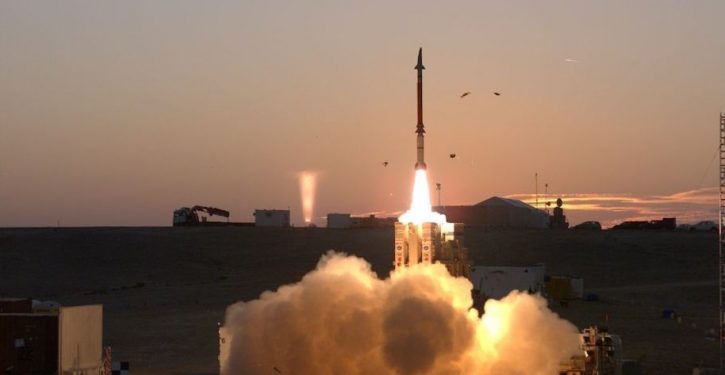
On Monday morning, Israel time, two David’s Sling air/missile-defense missiles were launched from northern Israel toward Russian-made SS-21 “Tochka” (Scarab) short-range ballistic missiles (SRBMs) used by the Syrian Army against ISIS fighters in Daraa Province.
The David’s Sling interceptors did not hit the SS-21 projectiles. However, the SS-21s reportedly landed in Syria, short of Israeli territory. The closest one came within a kilometer of the border.
One of the David’s Sling missiles was command-detonated by the IDF when it was clear there would not be an intercept. According to Times of Israel, the fate of the other interceptor has not yet been reported.
Will this presidential election be the most important in American history?
The Israeli missile commander made the decision to attempt the intercept based on the SS-21 trajectories, and the possibility that one or both could land in Israel. A number of reports have indicated that the initial projection showed the SS-21 might go as far as the Sea of Galilee (Lake Kinneret).
The map below depicts where the fighting was in the ISIS pocket in Daraa Province on Monday 23 July. Presumably, the SS-21s were launched to achieve impact somewhere in the ISIS-side rear of the line of confrontation (which is basically along the border of the ISIS pocket, give or take a few local penetrations by Syrian army forces).

The IDF decision to attempt intercept might or might not have been an “overabundance” of caution. We should definitely not presume to pass judgment on that. As regards where the SS-21s were going, the distance of the probable intended impact area from the Sea of Galilee is between 25 and 30 kilometers (15-18 statute miles). The circular error probable, or likely miss distance, of the SS-21 Scarab B in the Syrian arsenal is nominally about 95 meters; i.e., a tenth of a kilometer. (The SS-21 Scarab B version has terminal guidance that significantly improves its accuracy over the older version.) Thus, a predicted path that took the SS-21s much, much further than the CEP distance from the probable intended impact area would have been eye-opening.
The David’s Sling operational commander has to make his decision before the predicted trajectory of the missile has proven out, and has thus set the boundaries for applying the CEP. Waiting to be certain, within a kilometer, of where the threat missile will come down can mean waiting too long to be effective.
It’s for the IDF to decide if its commander made the right call. Knowing none of the exact details, we also can’t comment from here about the effectiveness of the David’s Sling system. This was its first combat launch, and we don’t know if the intercept geometry was going to line up to begin with. As others have noted, the SS-21 has some terminal evasion capability, and that may have been a factor (David’s Sling is a terminal-phase interceptor.)

In any case, the Golan between the ISIS pocket in Daraa and the Sea of Galilee is a crucial buffer for Israel. The IDF can’t afford to let it become a free-for-all for Syrian war overflow. And as the fight for Daraa and Quneitra advances on the Syrian side, the old mechanisms for holding the status quo in stasis have been crumbling away at an accelerating rate. That Israeli Golan buffer is more vital now than ever.
Not your father’s Golan framework
In many Western minds, the mental construct still exists of a slender buffer zone between Syria and Israel, watched over by the UN Disengagement Observer Force (UNDOF). (Between the dashed lines on the Syrian side, on the map above.) But it has been a long time since that structural idea had any reality. It became demonstrably toothless as early as 2013, when Al-Qaeda-linked fighters kidnapped two dozen UNDOF peacekeepers, and it has never recovered any authority, or ability to guarantee territory or combatant separation.
Although the UNDOF mandate continues to be renewed, and is in place through December 2018, the actual mission has been a sham since 2014, when UNDOF was forced to abandon its headquarters in the UNDOF zone. In the years since, peacekeeper activities in the zone have been undertaken, to all intents and purposes, at the sufferance of the Syrian factions.
One look at the current map shows that the entire UNDOF zone is occupied by the factions of the Syrian civil war. The Syrian rebel coalition occupies a small pocket around the Quneitra crossing; otherwise, the Syrian regime forces hold the area to the north. And a short span in the south is still held by ISIS.
It has been to the Assad regime’s advantage to maintain the perfunctory overlay of the UNDOF mandate. But that doesn’t mean Assad has respect for UNDOF. Symbolically, the regime seized control of the UNDOF observation tower in Al-Rafid (see map) in its advance on 22-23 July – a reminder that there will be no going back to the old UNDOF situation.
UNDOF observation tower near Al-Rafid under SAA control.#Quneitra pic.twitter.com/P1iOrI34sE
— Military Advisor (@miladvisor) July 23, 2018
The disposition of the Golan Heights is being set on a new trajectory by the application of hot lead.
At the moment, Bibi Netanyahu is devoting much of his time to diplomacy with Russia and the U.S., to ensure the best outcome he can get for Israel under the emerging conditions. Make no mistake, as our old POTUS used to say: this is an open-ended situation, not effectively subject to any prior principles or agreements behind the UNDOF deployment in 1974, but rather in the hands of the United States and Russia. There is no predestined outcome.
The U.S. and Russia are likely to invoke UN mechanisms in consolidating a settlement – if we get to that point. But it’s not “multinational agreement” that will carve out any no-kidding lines of settlement and local prerogative. It’s the guns on either side, and the guns and bombs of the wild card hovering over the whole situation: the United States.
Netanyahu owns the guns on one side. He has made it clear that his “red line” is advances by Iran and/or Iranian-proxy forces on the threat zone that now directly abuts the Israeli Golan. But that red line isn’t the same thing as a posture for a settlement, once ISIS has been annihilated in the Daraa pocket. Rather, it’s a trigger notification: a statement of what Israel cannot tolerate, and must react to.
We know what Russia and Assad – who own the guns on the other side – want: ISIS and the Sunni rebel coalition out, and full control of Daraa and Quneitra by the Assad regime. Russia may hold Iran in check for a time, to reassure Israel and prevent any unnecessary “triggers.” I have confidence in Netanyahu to not imagine that Putin can be trusted in that regard for the long term.
The wild card, however, is the United States. We aren’t used to being the wild card — nor is anyone else used to that condition, which explains a lot about the general tetchiness. It’s been nearly 80 years since America had that role. (We weren’t a wild card under Obama because everyone knew he would act ineffectively, or not at all.)
And there are reasons why the level to which Trump will be willing to force, enforce, or guarantee a settlement in the Golan — or in Syria as a whole — is hard to predict. One of the biggest is the lack of an authorization for the use of military force that would justify such an undertaking. That is an important concern for Trump’s base, and he isn’t likely to dismiss it out of hand.
Obtaining the necessary AUMF would probably be very difficult in the coming months. As things stand today, the post-9/11 AUMF under which we have forces operating in and around Syria is about defeating ISIS – a source of terrorism. That doesn’t cover deciding how much of the Golan should be occupied by Assad.
Russia and Assad may well view it as useful to resurrect some version of the UNDOF mechanism, once they have full control of the Syrian provinces in the southwest. If so, U.S. buy-in to that would probably be feasible with the right proposition.
Larger implications
But something important to understand is that there is no such thing as a “peace plan” with the Palestinian Arabs that can proceed separately from, and without integrated reference to, the security emergency for Israel in the Golan.
As the situation in Gaza remains fluid and unresolved, so the situation in the Golan is open-ended, and without a known or predictable date or type of settlement. In Hezbollah’s Lebanon, where Israel can be more certain what the threat is and what it will be, the threat is unabated and relentless in its consolidation.
On the plus side, Israel has more tacit support than ever before from key Arab nations – Saudi Arabia, Jordan, Egypt – for imposed stability in the Golan Heights. Those Arab nations don’t want Iran in the Golan any more than Israel does.
Meanwhile, the U.S. under Trump is ceasing to maintain the fiction that the Palestinian Authority of Mahmoud Abbas is a viable “peace partner,” as opposed to a shakedown operation that slow-rolls all proposals to its advantage and uses foreign aid to pay off terrorists who attack Israel. The actual effect of this U.S. shift (as opposed to the fictional depiction of the effect in the mainstream media) is to expose Abbas and his organization for what they are, and reveal the emptiness of expecting valid commitments from them.
With the Trump administration, it is as difficult as it was with the Obama administration to discern whether there is a comprehensive strategy at work – and even more difficult to divine what it might be. With Obama, we knew that the priority would be defensive triangulation, and that punches would invariably be pulled. “Leading from behind” pretty much meant what it sounded like.
With Trump, there are regular demonstrations of will, but regarding Syria and the impact of the civil war on the region, no obvious outline of a strategy. It may be that the Trump team is holding fire until conditions align for a comprehensive political and military push: on the problems in Syria, and Iraq, and Lebanon; and on the Iranian problem pervading all of them.
But aside from the fresh political effort to put the Iranian regime on notice – i.e., Secretary Pompeo’s speech on Sunday (and of course the CAPS-ly tweet from Trump; more on all that later) – little that looks systematic has been emerging.
To Iranian President Rouhani: NEVER, EVER THREATEN THE UNITED STATES AGAIN OR YOU WILL SUFFER CONSEQUENCES THE LIKES OF WHICH FEW THROUGHOUT HISTORY HAVE EVER SUFFERED BEFORE. WE ARE NO LONGER A COUNTRY THAT WILL STAND FOR YOUR DEMENTED WORDS OF VIOLENCE & DEATH. BE CAUTIOUS!
— Donald J. Trump (@realDonaldTrump) July 23, 2018
So when we see Syria lobbing the most powerful SRBMs in Assad’s inventory uncomfortably close to Israel, and Israel using David’s Sling for the first time, it’s of more than academic interest. “1974” died in 2014, and we don’t yet have a new touchstone date for the standoff line between Israel and Syria. This thing is off-balance, and only a steady, constant strain on the lines keeps it from wandering off where it shouldn’t. Israel, for obvious reasons, is doing virtually all of the line-tending. This is it: this is living in interesting times.




